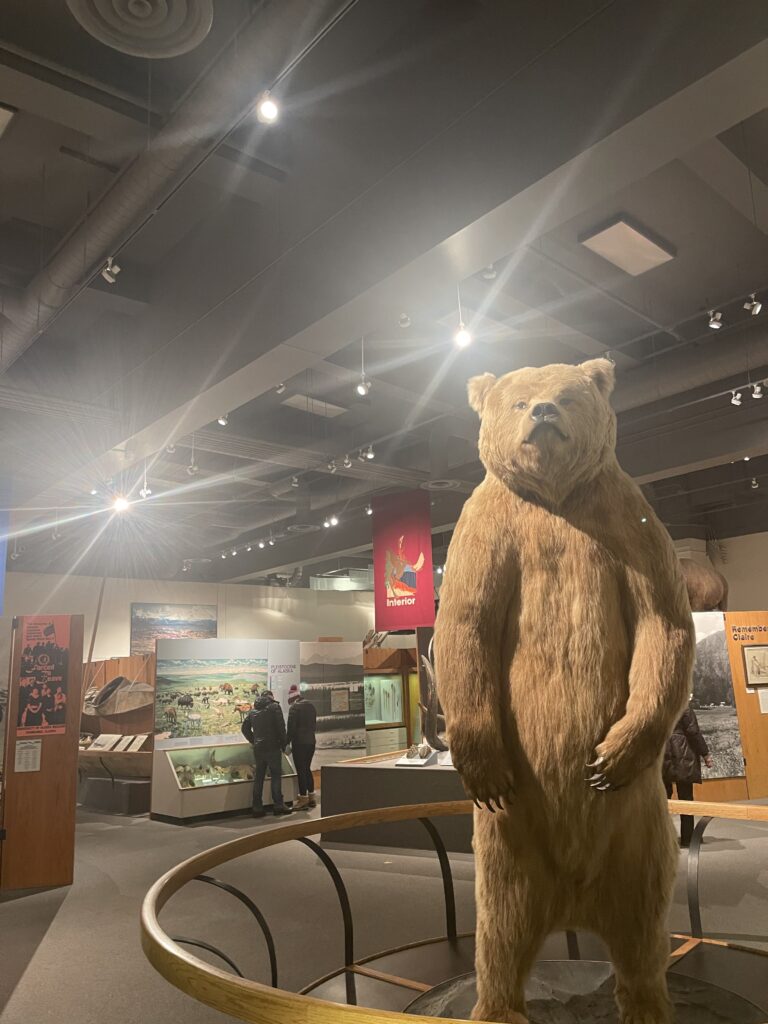For this week’s assignment, I decided to focus my research on Brown Bears. I chose Brown Bears simply because every time I exit my cubicle area there is a rather prominent Brown Bear outside my door. I don’t actually know too much about bears, I know they are in Alaska and I know they love human trash! I also don’t have a formal science background so I am mostly a stranger to any type of research database.
First thing I did was go to the Arctos search page. A simple search of “Brown Bear” gave me 2,391 results. Too many to get started for me. I decided to narrow down my results to just the UAM Mammals collection, which gave me 1,376 results. (Round of applause to the UAMN Mammals collection for this impressive collection!) The results came vastly from Alaska but also many of the western United States, and Mongolia. I was curious why there were so many results from Mongolia but I couldn’t find any notes on this. When I have looked up objects related to culture or community I have found all sorts of notes and attached stories but I wonder if this is not the regular practice for mammals and/or living species. This kind of brings me back to our discussions about who owns items at a museum and how they are documented. I wonder why this data can’t be found for formerly living species. Is there less accountability for where these came from? I can understand why smaller specimens might not have as much data associated with them (i.e flies.) But larger mammals, like bears, tigers, etc. I would think might have a note saying “hunter donated to the state in 1989, originated from xyz location.” I see locations but no real “source” for the data.
The earliest record from the UAM collection is from 1962 and the most recent data I saw was from 2006. I could not figure out a way to sort data, for example, Brown Bears from 1999-2023. After clicking around on Arctos for a bit, I tried to find the source of my research inspiration – Otto the bear himself. Unfortunately, I couldn’t find Otto in Arctos (I assume he must have a record, so I am going to presume my inability to find him is due to my inexperience using Arctos.) I will have to follow up on this – I know that most objects in the museum are accompanied by their Arctos ID number and I would be curious to see if that is included on Otto’s display. I also tried to see if there were any results across the board for a search of “Otto the Bear”, maybe something from the Ethnology and History collection, but I did not find anything.
I couldn’t find any Brown Bear photos in Arctos – again that could be due to my inexperience with the platform, or they could be private to the collector. When I think about other data that would contribute to my knowledge of the species I would definitely consider having photos of the collection.
I think that any metadata a museum has should be available to all of the appropriate people related to the object. Not all information is suitable for the public – especially for cultural objects, but I think the information should be available to people or organizations of significance. I know that UAMN takes all measures to ensure that data collected from deceased specimens will be able to be used for research for as long as possible (with DNA, it could be almost forever!)
My question for the class is – what kind of data do you think is inappropriate for museums to record?

That’s a great question. Even better is I have no answer for it because metadata is often overlooked by the general public, many people don’t even know metadata exist or is a thing. Yet that does not mean that some metadata should not be excluded or included. I’m not sure what metadata should be excluded. The best I scenario I can think of is a cultural example that points to the ingredients used in Voodun to create the toxin that induces a zombie state. Considering the practice is of scientific and cultural significance, some if not all of the psycho active ingredients should not be posted or shared because it may help malicious people create harmful poisons. That’s the best I can think of.
Following up on my own post – Aren Gunderson sent me the Arctos link for Otto! I’m not sure why he didn’t appear when I was searching.
https://arctos.database.museum/guid/UAM:Mamm:5063
I also still do not understand why there are no pictures – this guy is famous!
The primary reasons I can see not to include metadata is dependent on the subject. A definite case where metadata can and should be excluded is when dealing with human remains or certain ceremonial objects, which the population of origin doesn’t want the objects analyzed only preserved.